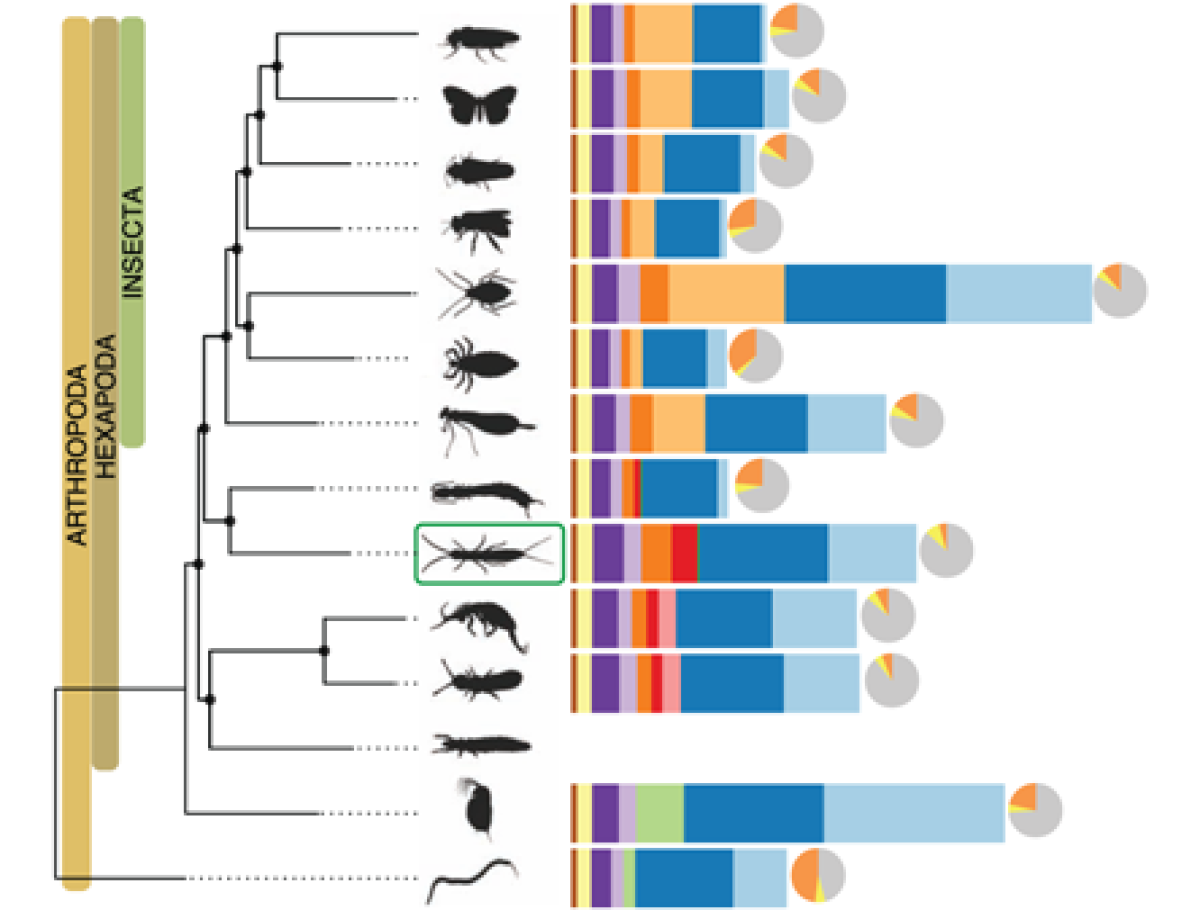Our groups
Ecology and evolution are essential scientific fields in our understanding of life and biodiversity on Earth, and are of growing societal relevance. The doctoral program in Ecology & Evolution brings together world-class research groups in an active and innovative academic community. The collaborative participation of various university departments, the Botanical Garden and the Museum of Natural History of Geneva reflects this interdisciplinary and vibrant academic environment. The scientific excellence of our internationally top ranked university is translated into a variety of high quality courses and activities. Moreover, participating students are eligible to join the activities organized by the University Conference of Occidental Switzerland (CUSO), enlarging their networking opportunities.

Spatial Predictions and Analyses in Complex Environments
Anthony Lehmann was a pioneer in the field of Species Distribution Modeling. He works on the use of eco-hydrological modeling to inform decision-making. He coordinated the FP7 enviroGRIDS project on the Black Sea catchment. He coordinated the H2020 GEOEssential project on geoprocessing workflows linking Earth Observation to policy indicators with Essential Variables. He coordinated the SNF SWATCH21 project on eco-hydrological modeling of Swiss rivers. He is working on the ValPar.CH project on Ecological Infrastructures in and around Swiss regional parks. He is associate editor for the journal Environmental Sciences & Policy, co-edited the MOOC on Ecosystem Services and is leading the local organization of an International Ecology conference in Geneva in August 2022.
Apply now

Plant and fungal systematics, evolution and biodiversity
The CJBG offers a unique research environment for scientists and students. Our research aims to document and understand plant and fungal biodiversity, to discover how species are related to each other, how they have evolved, and what evolutionary forces have influenced them over time, as well as which factors contribute to their distributions and overall biodiversity patterns. Linked to the University (Dep. of Botany & Plant Sciences) by the Lab. of Plant Systematics & Biodiversity, our botanists, systematists, morphologists, geneticists and bioinfomaticians undertake a wide range of research activities, from plant or fungal taxonomy and systematics, floristics, or vegetation analysis to phylogenetics, phylobiogeography, population genetics and vegetation mapping, modelling and prediction.
Apply now

Immunogenetics and human evolution
Our main scientific interest is to understand how human genetic diversity has been shaped during evolution. We focus more particularly on HLA genes, which are the most polymorphic of our genome. As these genes are involved in the immune response, their patterns of molecular variation are informative to reconstruct both the demographic history and migrations of human populations across the world and their interactions to their environments in terms of resistance or susceptibility to diseases (e.g. malaria). We are also interested in other related topics in anthropology, such as the co-evolution of genetic and cultural (e.g. languages) traits.
Apply now

Understanding plant speciation and diversification patterns
I am interested in the population genetics and phylogeography of diverse plant species. In recent years my projects have focused on groups of plants or genera for which species delimitation is an issue, due to hybridization, recent speciation events, and incomplete lineage sorting. To deal with such cases I am using the coalescent theory and various molecular markers (microsatellites, Sanger sequences, SNPs, NGS data) from different genomes (nucleus, chloroplast, mitochondria).
Apply now

Genomics and genetics in evolutionary perspective
Genomics and genetics is transforming with advances of sequencing technologies and bioinformatics. It also transforms the healthcare, from assessing human genetics, to tracking microbial outbreak or antibiotic resistance, and associating microbiomes with diseases. These big data challenge our computational techniques as well as our evolutionary models to interpret the genetic diversity.
Apply now

Computational simulations in population genomics
Our main research themes deal with the evolution of genetic diversity in populations, with a specific focus on humans. Our interests cover population genomics, ecology and evolution in general and more specifically the genetic consequences of past population dynamics, migration and admixture, combined to the effects of natural selection. We specialize in the development of computational simulation methods applied to ancient DNA to study the combined effects of various evolutionary forces on molecular diversity.
Apply now

Parasite diversity, ecology and evolution
Our research focuses on quantifying and describing the diversity of parasitic organisms, and understanding the evolutionary and ecological drivers of the associations with their host. We investigate how life cycle strategies, transmission modes and ecological processes influence the genetics of parasite species, their distribution and biogeographic patterns, by combining classical taxonomy with phylogenetics, population genomics and ecology. We study mostly aquatic parasites and develop museum collections as reference inventories of biodiversity.
Apply now

Evolutionary history of Mesozoic bony fish
Our main research focuses on the evolutionary history of bony fishes, i.e., ray-finned fishes (Actinopterygii), coelacanths, and lungfishes. We are interested in the anatomy, phylogeny, and paleobiogeography of these groups using fossils from a variety of paleontological localities, including Europe, Southeast Asia, the Middle East, and North Africa. We specialize in the study of coelacanths, focusing on their distinctive anatomy, their ecology and evolutionary dynamics over time.
Apply now

Pharmacogenomics and human evolution
We apply methods of population genetics and genomics to make inferences on the evolution of genes of pharmacogenomic interest in humans and in other primates. Our main research interests focus on the origin and evolution of genetic and genomic diversity in human populations, and its links to the history of migrations and cultural differentiations, such as the adoption of new subsistence strategies, which have probably left imprints in the current human genome. To understand the potential functional role of the genetic diversity observed in humans, we also investigate the variability of these genomic regions in other primates.
Apply now

Microbial Ecology
Our work is inspired by Hutchinson`s classic 1961 paper on «The paradox of the plankton». What are the mechanisms which control biodiversity of phytoplankton in lakes? We are convinced that in times of rapid environmental change a deep understanding of biodoversity at all levels – (i) its evolutionary origin, (ii) population genetic level, (iii) phytoplankton community level – in particular functional diversity, (iv) lake ecosystem level is indispensable to preserve biodiversity and the vital lake ecoystem services it supports.
Apply now

Study & conservation of tropical forests
Our group is committed to the conservation of tropical forests. To do this, we conduct research into predicting the distribution of species and environments to identify the most biodiverse and threatened, into ecology and biogeography to measure the importance of forests as links, into vegetation mapping to prioritise areas to be protected, and into the cological infrastructure to highlight forest fragments without protection status, as stepping-stones between protected areas. We work in close partnership with universities of several countries as well as with the 'Diversity and evolution of tropical flora and vegetation' and 'Spatial Predictions and Analyses in Complex Environments' groups, and are heavily involved in courses and internships at the University of Geneva and the CUSO.
Apply now

Plant systematics and evolution
We apply and develop phylogenetic and genomic approaches to study the evolutionary history and biogeography of plants. In particular, we contribute to reconstruct the plant tree-of-life and use this information in combination with morphological and ecological data to improve classification and explore the dynamics and drivers of plant diversification. The scope of our studies ranges from specific tropical lineages (e.g., Gesneriaceae, palms) to flora-wide patterns of phylodiversity in Switzerland.
Apply now

Microbiota-gut-brain axis and behaviour
Our group studies the interactions between symbiotic microorganisms and animal neurophysiology and behaviour. We aim to identify microbes with neuroactive potential, determine their influence on brain physiology, quantify their behavioural effects, and explore the evolutionary history of these microbiome-host interactions. We focus on the gut microbiota of social insects, like bees, as they express highly complex behaviours. For these studies, we conduct behavioural quantifications, use various -omics approaches, and employ advanced microscopy, manipulating the microbiome to infer causal relationships between microbiome composition and host behaviour.
Apply now












